'A life of public service': Halifax-born prime minister built legacy despite death at 49
CBC
Sat, December 30, 2023 a

Former prime minister John Thompson is buried at Holy Cross Cemetery in Halifax. Thompson was 49 when he died, not 50 as listed on the grave marker. (Vernon Ramesar/CBC - image credit)
On Dec. 12, 1894, Canadian Prime Minister John Thompson sat down for a luncheon with Queen Victoria at Windsor Castle. He died of a heart attack moments later.
Thompson, 49, born on Gottingen Street in Halifax, had only been in office for two years.
His legacy lives on in the Criminal Code of Canada that he introduced and in Dalhousie Law School, where he was a founder.
But his grave at Holy Cross Cemetery in the heart of Halifax is seldom visited today.
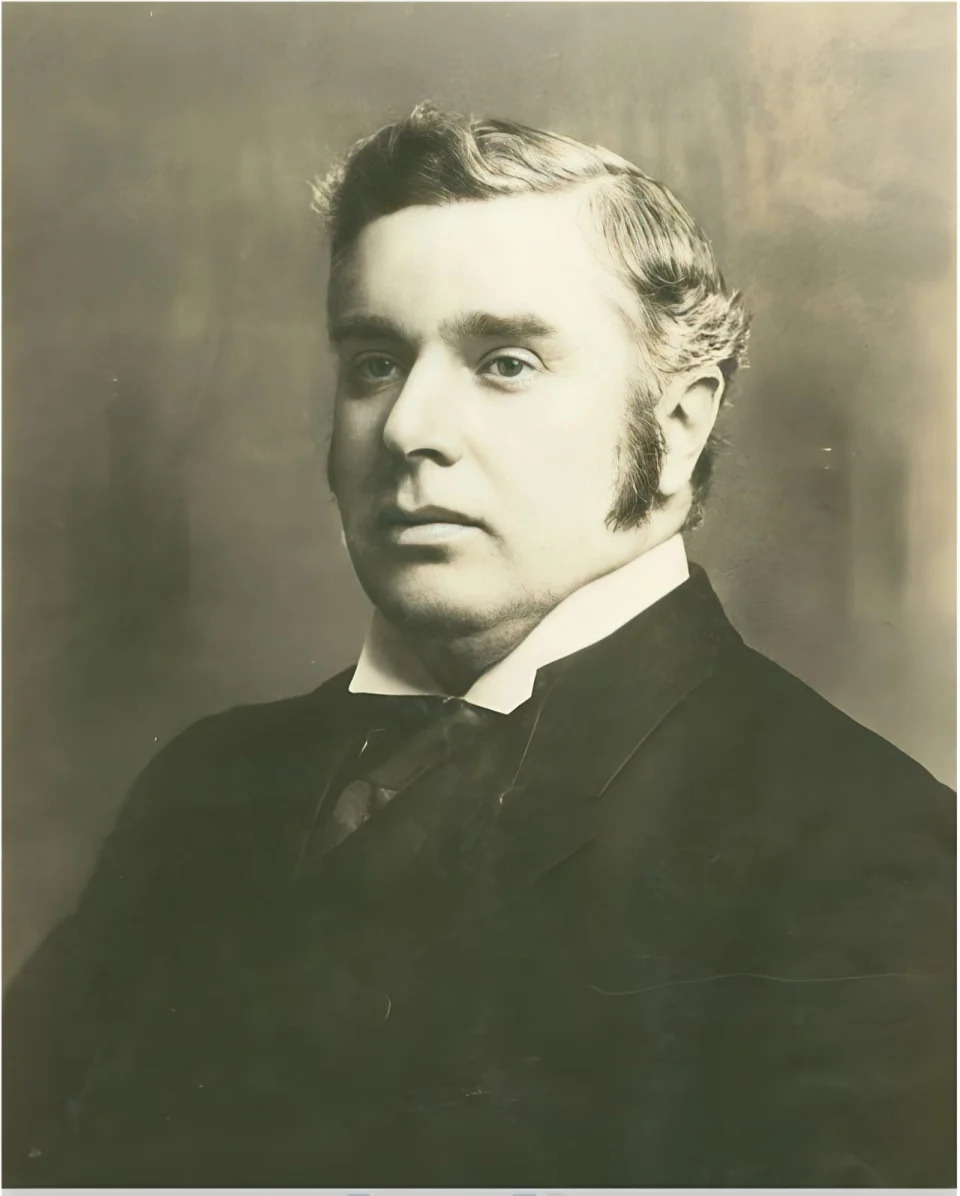
Portrait of John Thompson, the 4th prime minister of Canada.
Thompson was Canada's fourth prime minister. (Public Domain)
There are few other reminders in Halifax of the first of three prime ministers born in Nova Scotia.
He was followed by Charles Tupper and Robert Borden.
Life of public service
Will Langford, assistant professor of history at Dalhousie University, said Thompson "had a life of public service" despite his death before the age of 50.
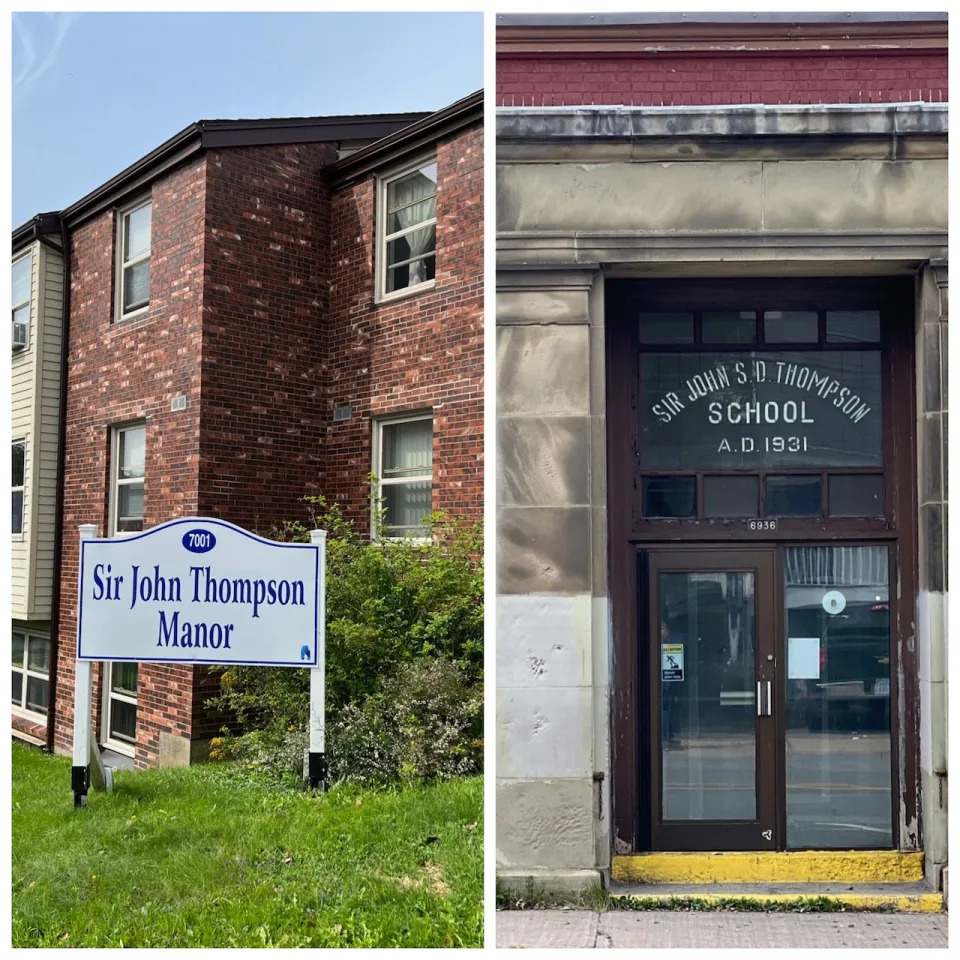
Today Sir John Thompson Manor senior complex on Leppert St. in Halifax is one of the few sites named after him. The complex incorporates the former Sir John S. D. Thompson school building.
Sir John Thompson Manor on Leppert Street in Halifax is one of the few sites named after him. The complex incorporates the former Sir John S. D. Thompson school building. (Vernon Ramesar/CBC)
Langford said after being admitted to the bar in 1865, Thompson was a lawyer and a judge before his remarkable run in politics.
"The offices he held as a politician were pretty prominent," Langford said.

Will Langford is an assistant professor in the history department at Dalhousie University in Halifax.
Will Langford is an assistant professor in the history department at Dalhousie University in Halifax. (Submitted by Will Langford)
He was attorney general of Nova Scotia as well as Nova Scotia premier, Langford said, then the federal minister of justice, Canada's fourth prime minister between 1892 and 1894 and the first Roman Catholic prime minister.
Thompson was appointed as a judge of the Supreme Court of Nova Scotia in July, 1882.
Dalhousie Law School
It was in this role that Thompson, along with lawyers Wallace Graham and Robert Sedgewick, visited Harvard and Columbia universities in the United States to observe their law schools.
They returned and helped set up the Dalhousie Law School in 1883.
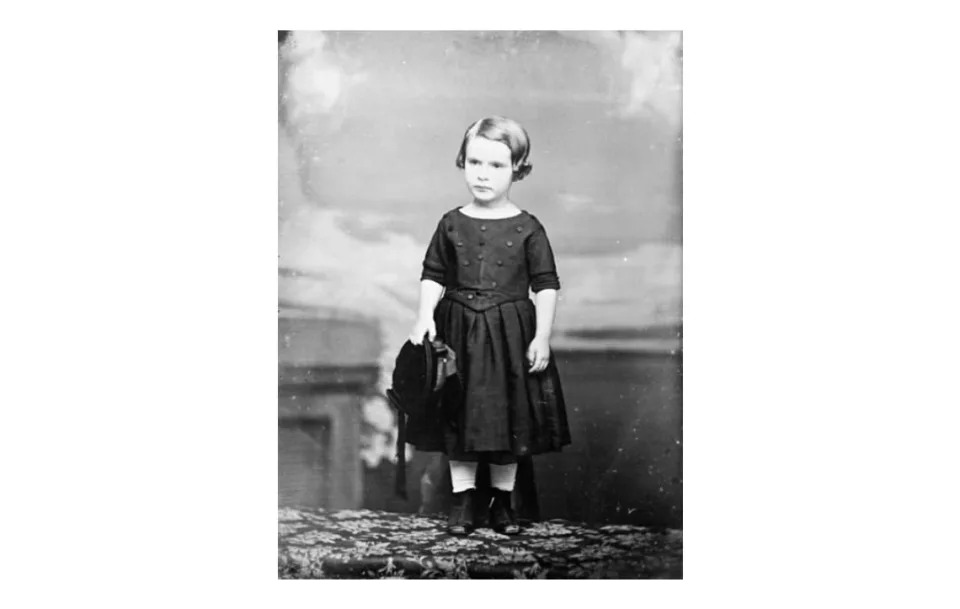
1851 portrait of John Thompson as a child in Halifax
Thompson as a child in Halifax in 1851. (Library and Archives Canada - PA-025800)
In his 1985 book The Man from Halifax: Sir John Thompson, Prime Minister, Peter B. Waite says the new school that Thompson referred to as the Dalhousie Law School experiment was an immediate success.
Waite said Thompson lectured on evidence at the school during the first two years of its existence.
"He made a great impression on the LL.B. students; they called him 'silver tongued;' he had a rich voice that carried easily and pleasantly," Waite said. "But it was his argument that established his reputation."
In 1885, Thompson was sworn in as minister of justice in Sir John A. Macdonald's government in September and elected as MP for Antigonish in October.
Criminal Code
As minister, he introduced Canada's Criminal Code which became law in 1892.
Legal academic and historian Philip Girard, a faculty member at Osgoode Law School in Toronto and a former law professor at Dalhousie, said introducing the code was Thompson's greatest accomplishment in terms of legal history.

Legal academic and historian Phillip Girard is a faculty member at Osgoode Law School in Toronto and a former law professor at Dalhousie University.
Legal academic and historian Philip Girard is a faculty member at Osgoode Law School in Toronto and a former law professor at Dalhousie University. (York University)
Girard said Thompson worked with deputy ministers and fellow Maritimers George Burbidge and Robert Sedgewick to push through the legislation despite resistance from many lawyers.
According to Girard, the code was innovative at the time as England did not have a criminal code, and laws on crime were "scattered all over the place" in hundreds of statutes and judicial decisions.
Criminal law was federal under the Constitution Act of 1867.
"The fact that you could use criminal law as a kind of unifying force in the country was important, and the federal government eventually realized this," Girard said. "The impact is still there today."
Langford said one aspect of the Criminal Code of 1892 that impacted many lives until fairly recently was that it criminalized homosexual relations.
"The men convicted more readily were young, often working class and it was immediate," Langford said.
"I found an annual report from Thompson ... when he was justice minister, and it showed convictions of men for gross indecency. They were receiving sentences of two to three years, and more often than not they were also receiving 50 lashes."
Thompson's legacy as justice minister has also become complicated over time because of his defence of the trial and execution of Louis Riel following the North-West Rebellion. Riel was hanged on Nov. 16, 1885.
Prime minister
Thompson became prime minister in 1892, after John Abbott retired after 17 months because of ill health.
When Sir John A. Macdonald died in office in 1891, Thompson had been asked to become prime minister.
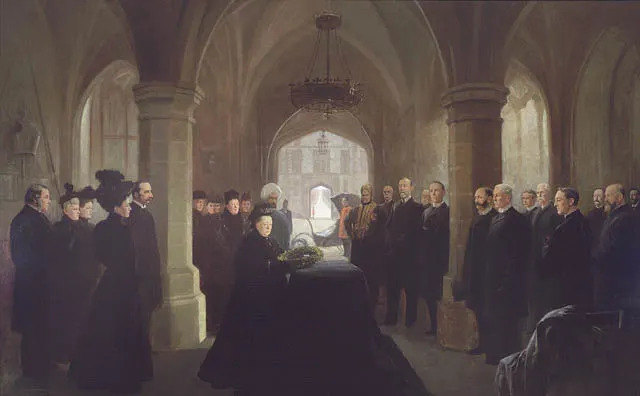
Queen Victoria’s Tribute to her Dead Canadian Premier by Frederic Marlett Bell-Smith, 1896 Library and Archives Canada
Queen Victoria’s Tribute to her Dead Canadian Premier by Frederic Marlett Bell-Smith, 1896, Library and Archives Canada. (Library and Archives Canada)
There were religious divisions in Canada at the time and Thompson declined the offer, believing that the country was not ready for a Roman Catholic in that role.
Thompson was born a Methodist but converted to Catholicism in 1871 and was christened at St. Mary's Cathedral in Halifax.
His wife, Annie, was also Catholic.
Father Paul Morris, parish priest of Saint Ignatius Church in Bedford, said having a Catholic prime minister was likely a significant milestone.
"Religion featured much more prominently in Canadian society generally and individual political leaders, their own religious affiliation, mattered far, far more than it ever would today," Morris said.
"One must assume that it would have been important to the Catholics of Halifax at the time."
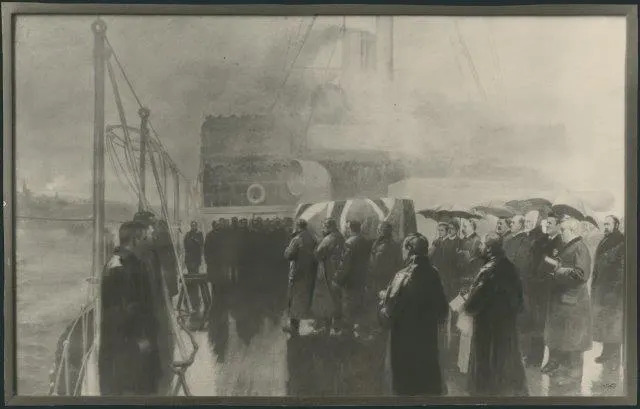
The arrival of John Thompson's body at Halifax Harbour aboard the warship Blenheim.
The arrival of John Thompson's body at Halifax Harbour aboard the warship Blenheim. (Library and Archives Canada, acc no. R13133-388, e011213232)
In late 1894, Thompson was invited to London to be sworn in as a member of the Imperial Privy Council.
Years of work and inattention to his health were taking a toll.
While in London he consulted prominent physician Russell Reynolds before going on a tour of Europe with his family.
In his 1895 book Life and Work of the Rt. Hon. Sir John Thompson, Hopkins J. Castell said Thompson experienced shortness of breath and other symptoms but continued with the tour before returning to London in December for the swearing-in ceremony.
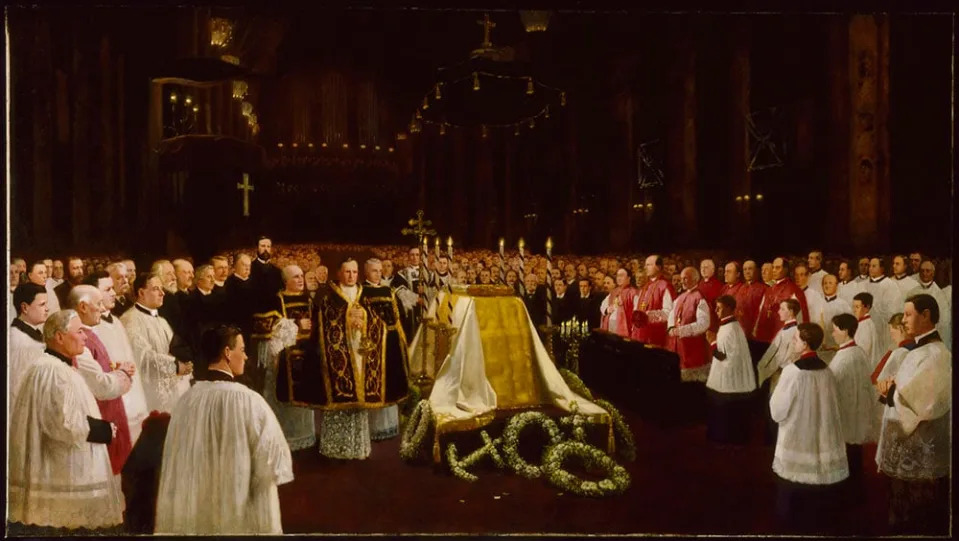
The State Funeral of Sir John Thompson at Halifax by Frederic Marlett Bell-Smith, 1897
The State Funeral of Sir John Thompson at Halifax by Frederic Marlett Bell-Smith, 1897 (Library and Archives Canada)
After the ceremony at Windsor Castle on Dec. 12, Thompson fainted only minutes after sitting down to lunch.
Death at Windsor Castle
He was examined by the Queen's physician, Dr. Reid, and returned to the table.
Castell quotes the account of Lord Breadalbane, who witnessed the event.
"Before he tasted the cutlet or whatever was placed before him, I saw him suddenly lurch over, and fall almost into Dr. Reid's arms.
"The room was partially cleared and everything possible was done, but without avail. The end had come."
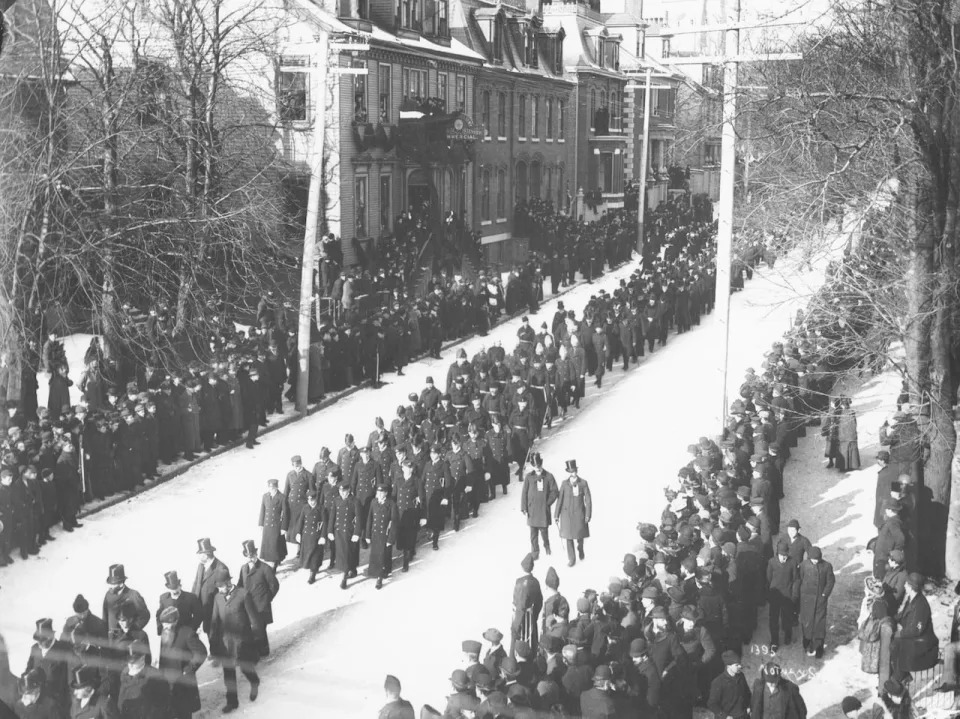
State Funeral procession for Sir John Thompson, Prime Minister of Canada, photographed on Barrington Street, Halifax, Nova Scotia, January 3, 1895
State Funeral procession for Sir John Thompson, Prime Minister of Canada, photographed on Barrington Street, Halifax, Nova Scotia, January 3, 1895 (Notman Studio/Nova Scotia Archives 1983-310 number 1395)
Thompson's body was placed in a coffin and moved to a room at the castle.
Upon hearing that the late prime minister was Roman Catholic, Queen Victoria, the titular head of the Anglican Church, ordered that a requiem mass be said for him.
According to Morris, it was likely the first Catholic Mass held at Windsor Castle since the reformation.
Return to Halifax
After lying in state at the castle for several days, Thompson's body was transported from Windsor to Portsmouth in a special train to be transported back to Halifax on the warship Blenheim.
The ship was painted black by order of the Queen.
As Thompson's body was moved to the ship, there was, according to Castell, a "crashing discharge of guns" from HMS Victory docked nearby.
The Blenheim was met by a large crowd at Halifax harbour when it arrived.
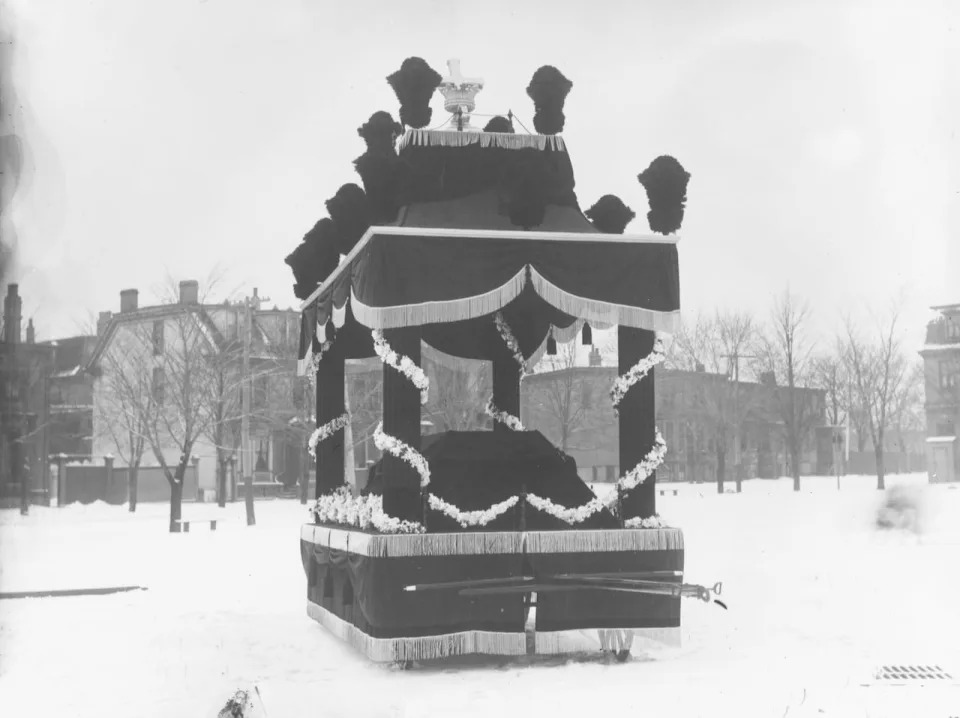
John Thompson funeral car shown in Halifax in 1895.
John Thompson funeral car shown in Halifax in 1895. (Notman Studio/Nova Scotia Archives 1983-310 number 1411)
Thompson's body lay in state at the legislative council chamber in Halifax for a day before being taken to St. Mary's Cathedral for a state funeral on Jan. 3.
Following the funeral, the coffin was transported amid mournful music down Barrington Street, past buildings draped in sombre colours, to Holy Cross Cemetery.
"Here it had been decided to lay the remains of Sir John Thompson," Castell said.
"And here, after a few final prayers by Archbishop O'Brien, all that remained of the distinguished Canadian was hidden from sight in the soil of his native province; in the heart of his native city. Sir John Thompson was now at rest."
No comments:
Post a Comment